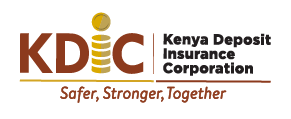KDIC is the country’s agency that works with other Government agencies to resolve a troubled bank.
The Corporation employs various strategies to resolve a bank. These include; Early detection and intervention; Protected Deposit Payout; Liquidation.
“Deposit Insurance” or “Deposit Payout” is a mechanism implemented by a country to protect bank depositors - in full or in part, from losses caused by a bank that has been placed under liquidation by the Central Bank, due to its inability to meet its financial obligations.
Deposit payout is the second option invoked by the resolution authority where intervention measures have failed to RESOLVE the bank
KDIC protects depositors of the banks which are licensed and regulated by the Central Bank of Kenya.
All commercial banks that are licensed and regulated by the Central Bank of Kenya.
NO. The annual premium for this protection is paid into the Fund by the banks that are members of KDIC.
|
|
Deposit Insurance System |
Conventional (normal) Insurance system (companies) |
|
Purpose:
|
1.To protect bank depositors,
2.To promote the country’s financial stability.
|
To insure specific policyholders against specific risks. |
|
Who are the Beneficiaries? |
Depositors of banks licensed and regulated by Central Bank of Kenya. |
Policyholders |
|
Who is Insured? |
Bank (member institution) |
Policyholders |
|
Who pays the premium? |
Banks pay a premium to KDIC. |
Policyholder pay premium to the insurance company/agent |
|
When is compensation done? |
When the bank is placed in liquidation by Central Bank. |
When the specific risk insured happens. For example, a vehicle is stolen or involved in an accident; |
|
What’s the Maximum compensation? |
Kshs. 500,000 per person in an institution, and further payments as per recoveries made |
Varies based on the insurance policy and the sum assured |
There are three stages of resolving a bank that is experiencing challenges namely:
1. Receivership:
A bank is placed under receivership if it fails to meet its financial obligations - including failure to pay its depositors - when they fall due or as per the provisions of KDI Act. During this period, KDIC in conjunction with CBK and The National Treasury will explore possibilities to resolve the bank with a view to resuming normal banking operations within a specified timeframe.
2. Liquidation:
This is the second stage after receivership during which depositors are paid the protected amount of Kshs. 500,000, subject to complete document as provided for. Further payments are made to depositors and creditors upon recovery from the assets of the failed bank.
3. Winding up:
This is the last stage of the bank resolution process. It involves dissolving the bank after its assets have been realized and proceeds distributed to depositors and creditors.
-
KDIC does not resolve depositor-related complaints/cases such as mistaken deposits.
Physical Address: UAP Old Mutual Towers, 23rd Floor, Upper Hill Road.
For complaints: customercare@kdic.go.ke
For whistleblowing: fichua@kdic.go.ke
General information: customecare@kdic.go.ke
For press related requests: kdiccommunications@kdic.go.ke
Postal Address: P.O. Box 45983 - 00100, Nairobi.
Website: www.kdic.go.ke
